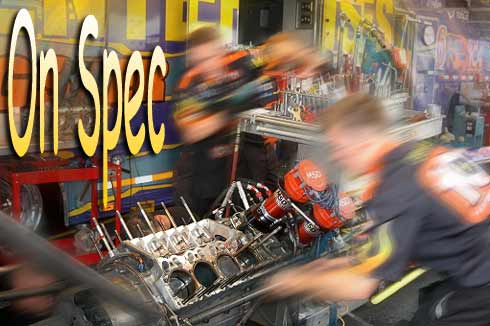
By Jeff Burk
Photo by Ian Tocher
3/8/05
 n the first day of qualifying for the second race of NHRA's
2005 POWERade series at Firebird Raceway in Phoenix, AZ a
press release appeared on NHRA.com. That press release was
nothing less than monumental in the 50-plus year history
of drag racing. For the first time the term "spec engine" was
mentioned in the same space with the words "Top Fuel
and Funny Cars." n the first day of qualifying for the second race of NHRA's
2005 POWERade series at Firebird Raceway in Phoenix, AZ a
press release appeared on NHRA.com. That press release was
nothing less than monumental in the 50-plus year history
of drag racing. For the first time the term "spec engine" was
mentioned in the same space with the words "Top Fuel
and Funny Cars."
The press release, which I will quote in portions of this
article, combined with another NHRA tech department decision
that makes a rev-limiter mandatory for NHRA Top Fuel and
Funny Cars beginning with the NHRA Gatornationals, effectively
puts the final nail in the coffin of any unlimited fuel class
in drag racing. That situation has been de facto for some
time, but by issuing that press release the NHRA actually
made it official. The Top Fuel and Funny Car classes are
officially just another spec -- albeit a very fast -- drag
racing class similar to Pro Stock, Super Stock and Alky dragster.
For some time now both the NHRA and IHRA Top Fuel and Funny
Car classes have been among the most heavily regulated classes
in any motorsport. The reasons given for virtually every
rule change in the past were to curtail performance, reduce
engine failures, and to lower the cost of racing fuel cars.
Up to now the rules have failed to accomplish any of those
things.
There is no doubt that the cars are quicker and faster than
they were before the nitro percentage was reduced. From my
casual observation there are just about as many explosions
and oil downs as there have ever been. I've not found one
team owner who would say any of the rule changes for fuel
cars have done anything but cost them money, and I talked
to a variety of team owners from Don Schumacher to Jack Wyatt.
So, the question now is how will the spec engine rule and
a mandatory rev-limiter affect Top Fuel racing in the near
term? NHRA
spokesmen have said that the "spec" engine program
is designed to level the playing field by improving the flow
of quality parts from the well-funded teams to the lesser
funded teams and to reduce the cost of fuel racing by outlawing
the production of exotic, expensive engine parts through
a mandated moratorium on engine and engine component development.
Here is a quote from the NHRA release:
"The NHRA engine moratorium is intended to control
the escalating cost of drag racing at the sport's highest
level, while at the same time maintaining equity between
the highly financed operations and the less-financed teams.
It is NHRA's opinion the engine moratorium and direction
of an NHRA 'Spec' race engine, in Top Fuel and Funny Car
will strengthen the flow of used parts from better-financed
teams down to other competitors. This will offer the lower-financed
teams the opportunity of equal performance potential with
the higher funded operations. The engine component and cylinder
head moratorium
ADVERTISEMENT
 |
includes, but is not limited to, engine blocks,
cylinder heads, intake manifolds, fuel injectors, and superchargers.
This includes any redesign, reconfiguration, and/or significant
modifications to existing components."
One of the NHRA employees who is responsible for enforcing
the rules told a gathering at Phoenix in John Force's technical
center trailer that NHRA felt both current and potential
corporate sponsors of fuel teams were concerned about race
team's cost of maintaining a competitive engine program.
However, based upon the conversations I had with several
team owners with corporate sponsorship their sponsors were
concerned about just one thing: How many people will see
the cars with my company logos on them. One crew chief I
talked to (who asked not to be identified) told me that the
sponsors couldn't care less how the teams spend the sponsorship
dollars.

|
